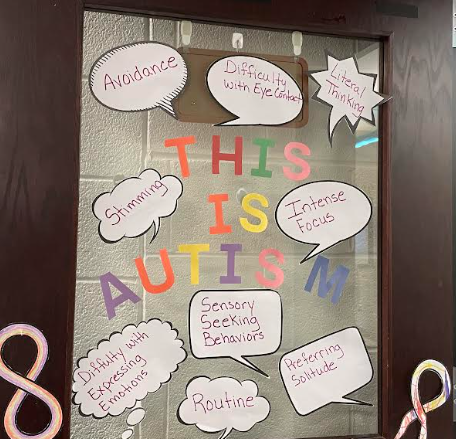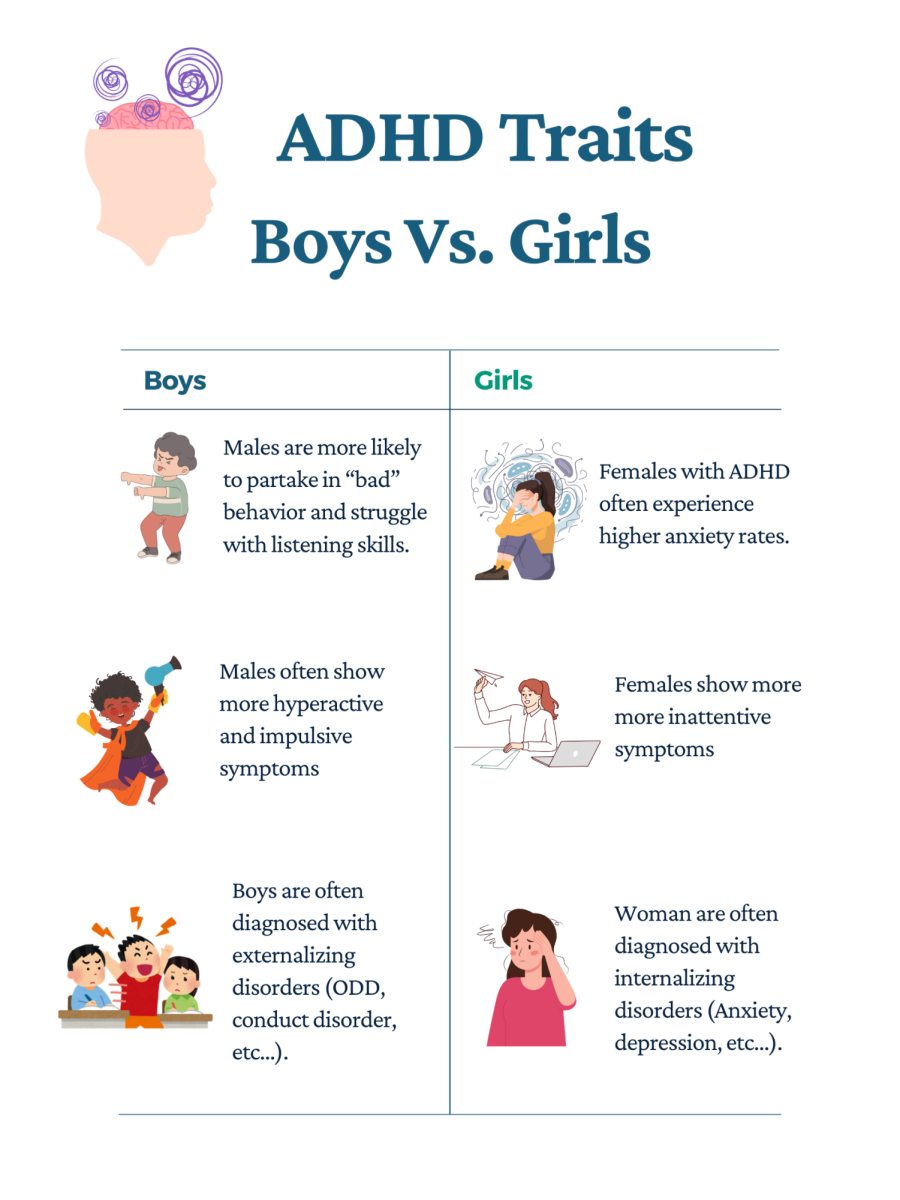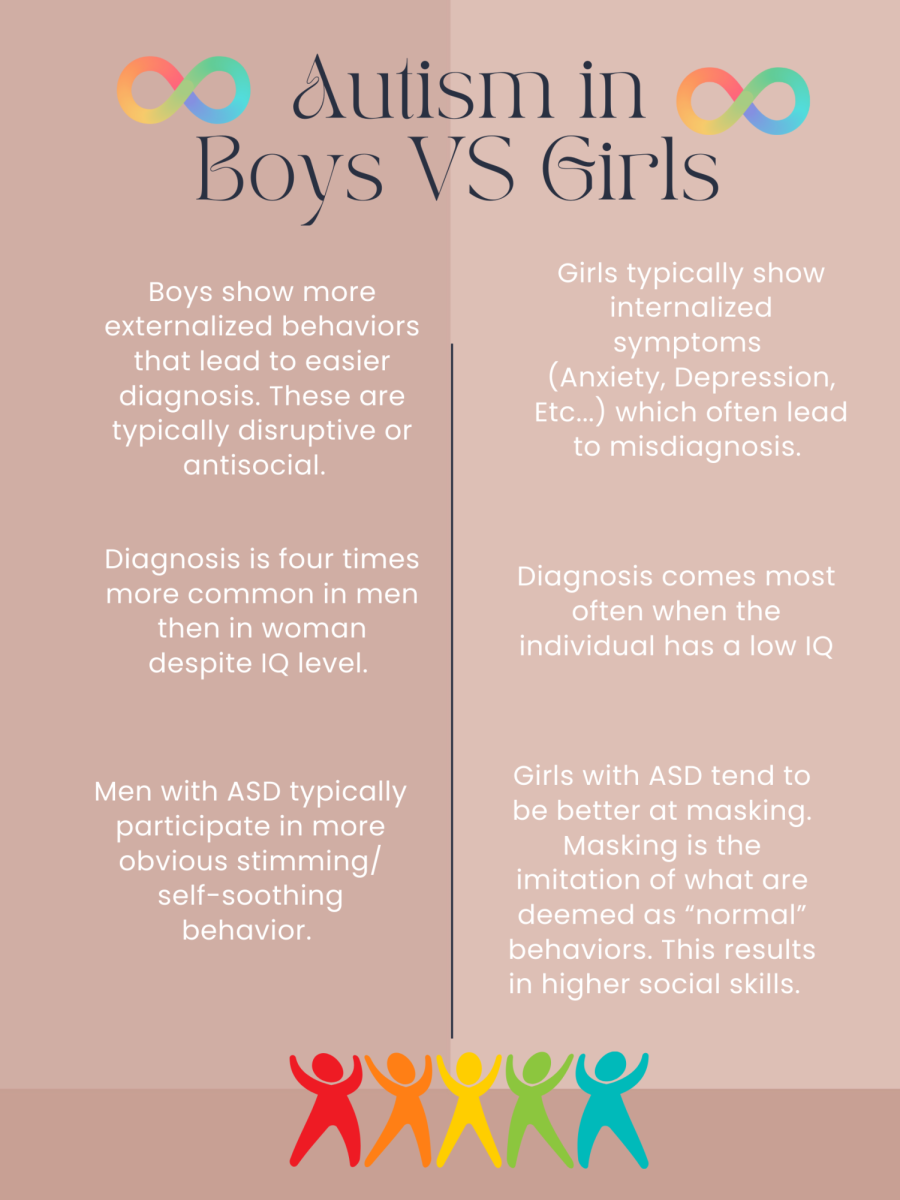Stopping the stigma

In the past, the treatment of neurodivergent people before extensive research was conducted and understanding was achieved was discriminatory. They were often thrown into asylums and prisons and treated as if they were insane, typically restrained, punished, or medicated.
Today, the understanding of neurodivergence is just beginning to unfold. Still, too many are uneducated on the topic and believe it’s something to be cured.
With a new generation of change has come new narratives.
Originally, Autism Speaks, an Autism Spectrum Disorder (ASD) research center, had approached ASD as a burden to be erased and treated. In 2009, they released a video in which autism was framed as a monster with autistic people being burdens to their environment.
Naturally, the autistic community was appalled.
“We don’t want to be portrayed as burdens or objects of fear and pity,” Ari Ne’eman, president of the Autistic Self-Advocacy Network, said to Time.
Neurodiverse people still have issues with the organization because it promotes fear and stereotypes from the past.
“I think Autism Speaks is a front for autism as a whole. It wasn’t created with good intentions and was built on eugenics,” states Norah McCabe, ’25.
It’s because of this idea that ASD means you have something missing, the autistic community has changed its symbol from a puzzle piece to a rainbow infinity symbol.
The infinity symbol represents the idea of infinite possibilities and acceptance. The rainbow is often associated with diversity and inclusion,” explains the Autism Institute. “Butterflies are also another well-known alternative, and they symbolize transformation and growth.”
Biases can present in the way people are referred to.
The Autism Self Advocacy Network expresses that when someone says ‘with autism’ instead of ‘autistic’ it implies the person would be better off not being neurodivergent. By saying ‘autistic,’ the person’s identity is painted in a more positive light.
While this may seem silly, the most important takeaway is how people discuss these labels. Everyone has a different relationship with their diagnosis. Don’t be degrading or insulting. Understand that while there may be sensitivities to labels, they aren’t insults.
Unfortunately, the use of autistic, dyslexic, ADHD, and most neurodivergent labels still has negative connotations.
When neurotypicals use phrases like, “She’s so bipolar,” “Are they acoustic?” and “I’m so ADHD I just can’t focus,” it’s not only negative, but also undermines the experience of having these disabilities.
The novel “The Power of Neurodiversity: Unleashing the Advantages of Your Differently Wired Brain” by Thomas Armstrong, Ph.D., explains a study that was done to prove the power of a label.
Armstrong states that when comparing words used to describe people with ADHD and creative people, “The lists appeared to be indistinguishable except for the fact that the words used for the ADHD individual were negative and those used for the creative person were positive.”
The ADHD person was “impulsive,” but the creative person was “spontaneous.” Once people decide someone is odd or troubled, they only see the negative aspects.
This negative view creates negative expectations and views of neurodivergence.
A video released last year titled “Assume That I Can So Maybe I Will ” starring actress and model Madison Tevlin, was made for World Down Syndrome Day and challenges these stereotypes.
In the video, Tevlin expresses that if everyone assumes she can’t do something and refuses to teach her, she won’t be able to do it. Instead, treat her like everyone else, and she’ll be able to do great things.
“When I was born, the doctor told my mom and dad that life would be really hard for me, saying that I can’t talk, or walk, or dance, or model, or act — or drink or get married — any of this stuff that’s part of normal life,” expressed Telvin in an interview with CNN, “And it’s so much fun proving people wrong.”
Simplifying things because of the assumption that a neurodivergent person can’t understand it is not only degrading and insulting, but it can lead to codependency. Just as the video said, “If your assumptions become reality, then assume [they] can.”
Labels can easily become stereotypes.
CPD Online College explains that labels “from childhood might affect future potential and how we see ourselves.” It leads to the internalization that people are incapable of change or exercising expectations because “every time you or someone does something that supports the label, your brain interprets this as proof that the label is true…”
Looking at neurodivergence in a positive light helps break down the stigmas that surround it. Ignore the stereotypes and listen to neurodiverse voices.
Part of the stereotypes following disabilities is a certain “look” people expect to see.
Some people struggle to imagine neurodiversity can be invisible to the blind eye.
When picturing ADHD most people would imagine a hyperactive little boy. What someone might not expect is a quiet, daydreaming girl.
Neurodivergence doesn’t have a “look”, but it can present differently in girls and boys. Many doctors don’t take this into consideration and misdiagnosis is common in woman.
The American University of Beirut explains, “… the diagnostic criteria for many neurodivergent conditions were historically developed based on studies conducted mostly on males, resulting in a male-biased diagnostic framework.”
The suppression of neurodivergent traits and mimicking of neurotypicals (masking) is common in neurodivergent girls. It can be taught and may happen without the individual realizing, so neurodivergent traits become harder to recognize.
The Autism Service states, “… an autistic girl could be interpreted as shy or quiet, but still be part of a friendship group at school. Being introverted can often be seen as a more feminine trait, which can be brushed off as normal behavior. This can make it difficult for a parent or teacher to know if they have autism or not.”
For autistic women, stimming may be subtle like the twirling of hair. Masking often includes forcing eye contact, hiding special interests, and having a planned mental script for social situations.
I’ve gotten really good at masking, but the act itself is draining and damaging. There was a blockade when I was getting diagnosed. How were they supposed to know I had autism when I mastered hiding it? An act so subconscious that for 16 years I assumed it was normal to practice conversation, memorize appropriate responses, forcing myself to fit into social standards that have never made any sense?
I had to learn to be uncomfortable because any natural behaviors would get me reprimanded.
It caused a nightmare where I didn’t know what parts of my identity I fabricated to fit in and what was real. I felt like I mirrored those around me, an actor that gets so engrossed in their role it becomes a part of them.
According to The Misdiagnosis of Neurodivergent Women, “Women with ADHD may not exhibit the hyperactivity that is often associated with ADHD in boys but instead may present with inattentiveness, impulsivity, or other symptoms that are less commonly recognized as ADHD in girls and women.”
People of color are also less likely to get diagnosed with a neurodivergent disorder.
In an experiment with Everyday Health, a study showed “Black children were 36 percent less likely and Latino children were 56 percent less likely to be diagnosed with ADHD,” than other children.
“There’s always that stereotype of autistic people being an eleven year old white boy whose special interest is trains. Especially as a woman of color whose high masking, you are not taken seriously. I was so good at pretending to be ‘normal’ it took a while to get diagnosed,” expressed McCabe.
Early diagnosis allows kids to get accommodations in school, gives time to teach them to manage negative symptoms, and allows family support. It’s hard for many neurodivergent people to get early diagnosis when these stereotypes still exist.
There must be some understanding that neurodivergence isn’t a sickness, neurodivergent people shouldn’t be treated like children, and being neurodivergent doesn’t mean you look a specific way.
Negative stigmas can be demolished if people can look over their bias and educate themselves on the subject.
While we as a society like to think bullying is a thing of the past, it’s still a common experience for neurodivergent people.
“Up to 94 percent of autistics report experiencing bullying in school,” according to Embrace Autism, “Furthermore, 87 percent of autistics report being bullied weekly and 40 percent report being bullied daily, compared to 15 percent of neurotypicals.”
Ambitions expresses that up to 75 percent of dyslexic people have been bullied and the National Library of Medicine (NIH) states that about 47 percent of kids with ADHD have experienced bullying.
“…People with autism are more likely to be bullied, and this is especially concerning when these children are also more likely to have other mental health concerns…,” said Thomas W. Frazier, Ph.D., chief science officer at Autism Speaks.
Stroudsburg High School has always worked hard to make sure everyone is safe and cared for, but no matter the location bullying is bound to happen.
Nowadays it isn’t kids getting shoved in lockers or called mean names. Bullies are wolves in sheep’s clothing. Insults are played off as friendship and public shaming has become more popular.
It’s become pretending to be friends with someone as a joke, mocking their struggles, and much more.
When you’ve experienced it, you notice just how often it happens. I see it too much for comfort among peers that, when push comes to shove, have no back bone.
It can be tricky for neurodivergent people to understand if and why they’re getting bullied because of difficulties with social cues.
Picture this: a group of students allows an autistic kid to think they’re friends. They talk to him, laugh at him, and make it a big joke among their friend group.
On the surface, it may seem like fun. The kid doesn’t understand, it’s for a laugh, why should it matter?
Besides the obvious cruelty, what happens when in the future this kid is subjected to abuse (because, yes, bullying is a form of abuse, mental or physical) and thinks it’s okay because that’s how his “friends” treat him?
What about that autistic girl on the playground trying to make friends? She understands the other kids don’t want to play with her, so when a group comes up and invites her to play for a day, torments her the whole time, and then leaves, what’s left?
I say this because I’ve been that girl.
We remember. We internalize. Life is hard enough being different, don’t punish us for trying to live a normal life.
Even when they make friends, these kids will be cautious every time they hear someone laugh, and question if compliments are insults. Socializing becomes more difficult to navigate as we get older because the inuendos become more obscure.
Springer Nature states that almost 60 percent of autistic people report having been physically abused, and 70 percent of autistic people report having been emotionally abused.
This all becomes a bigger concern with the high rates of suicide of neurodivergent people.
According to Government Events, “Autistic people make up approximately 1 percent of the population but 11 percent of suicides, and with estimations that there are over half a million undiagnosed autistic adults in the UK, this percentage may be higher.”
Use the resources SHS has provided. If you see someone being bullied, if they recognize it or not, report it to a teacher, use Safe2Say, and if you engage in this behavior, remember those suicide rates and consider if getting a pity laugh is worth it.





